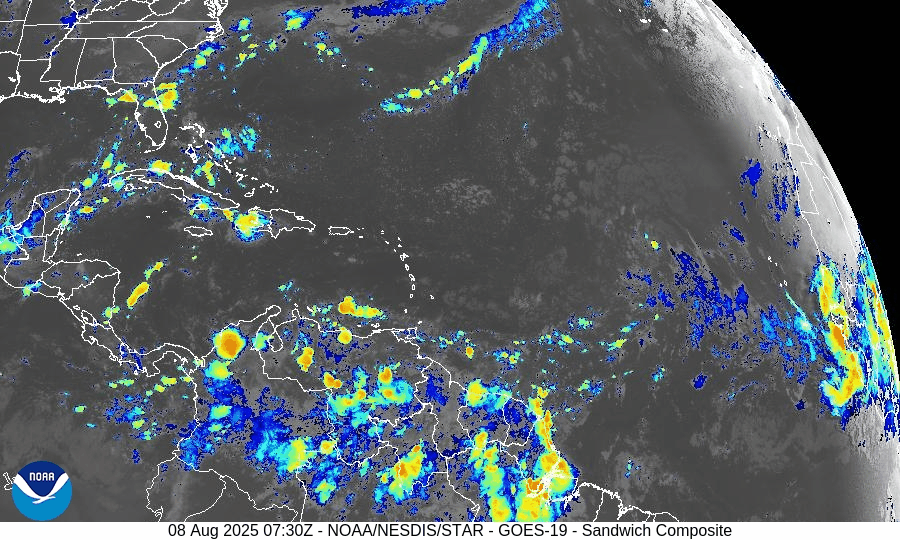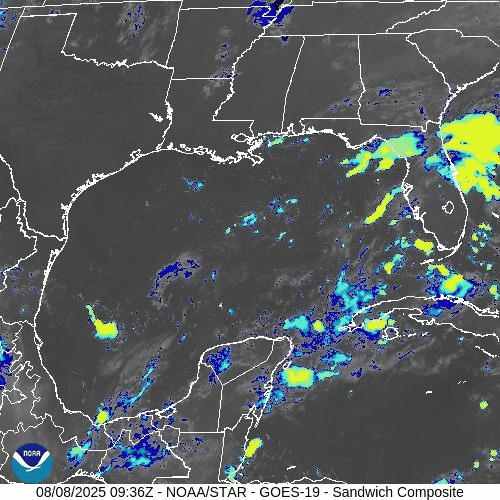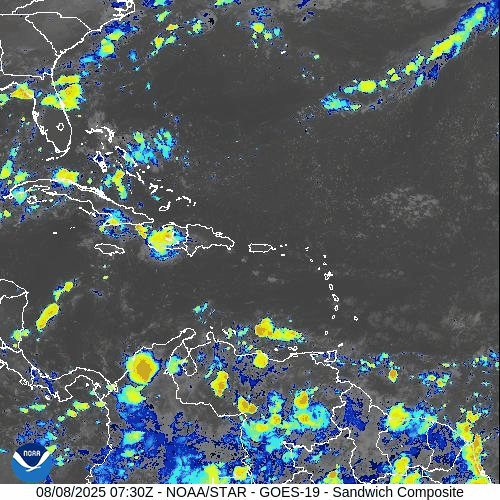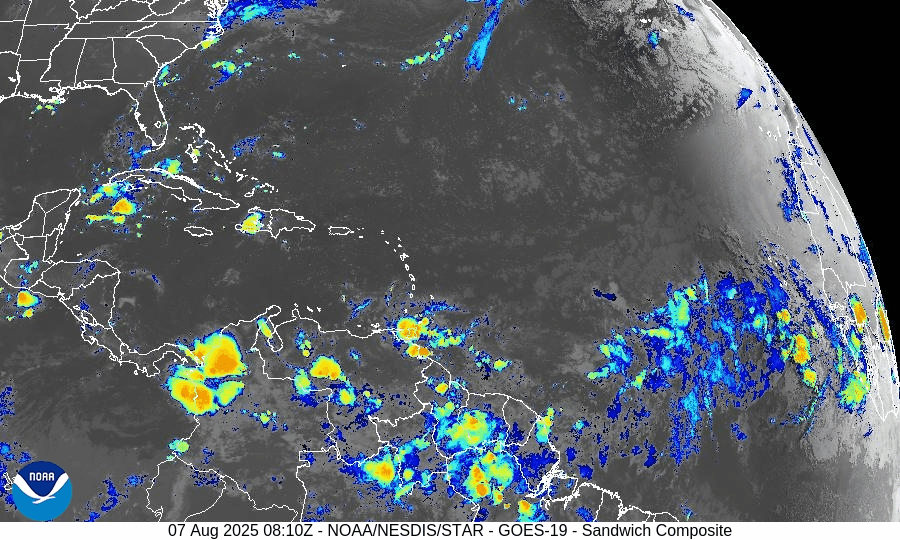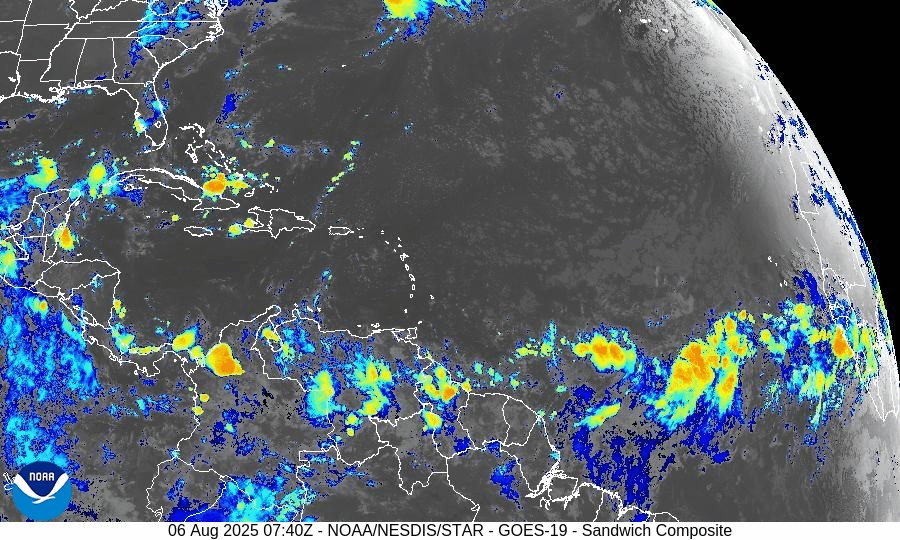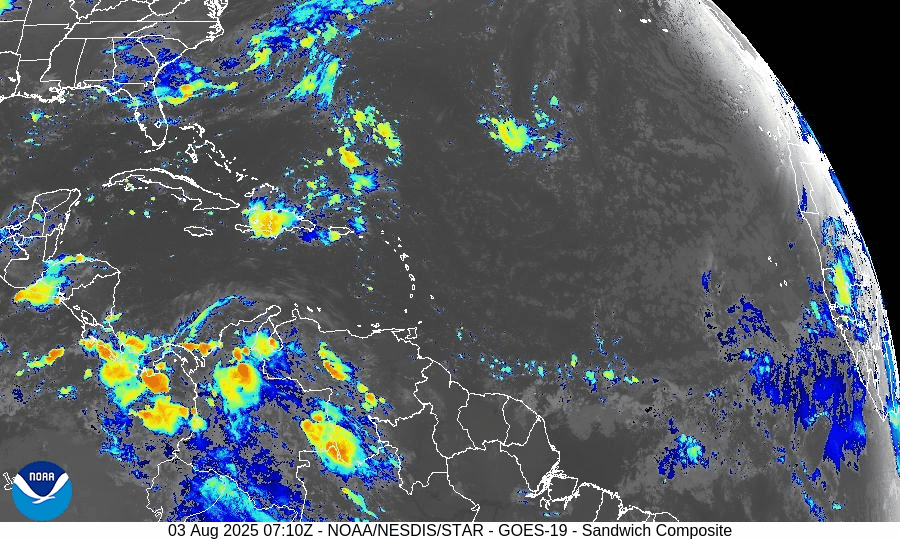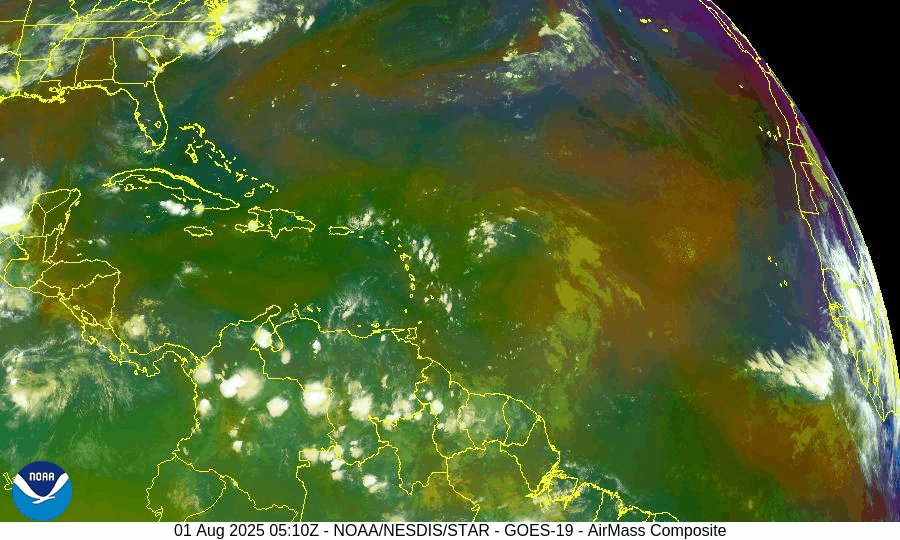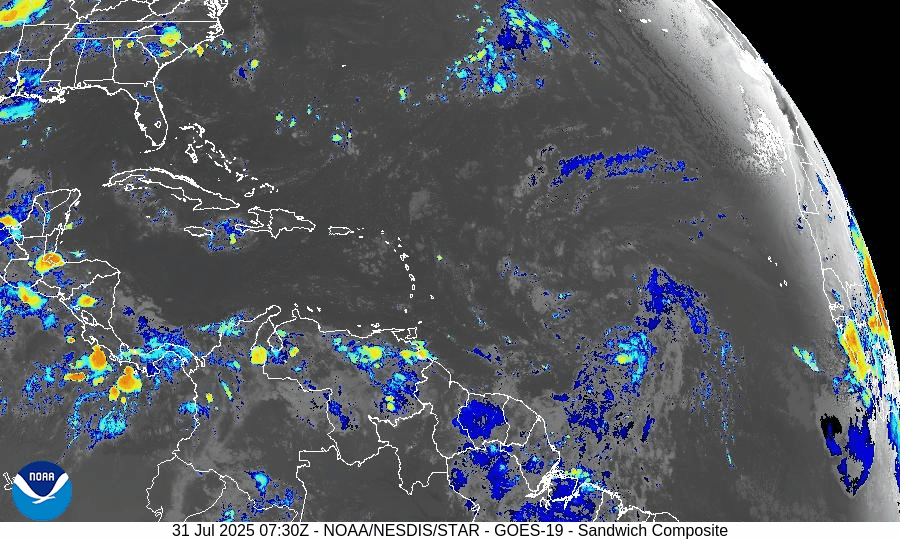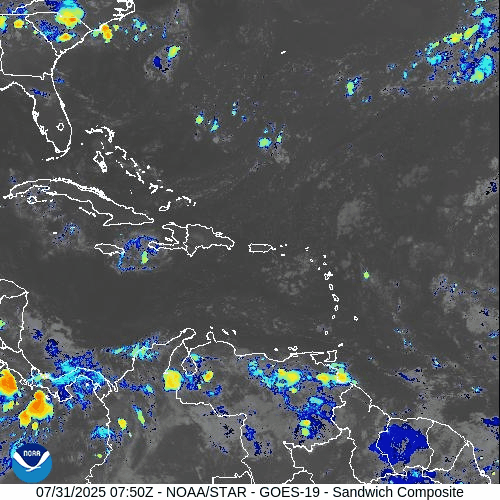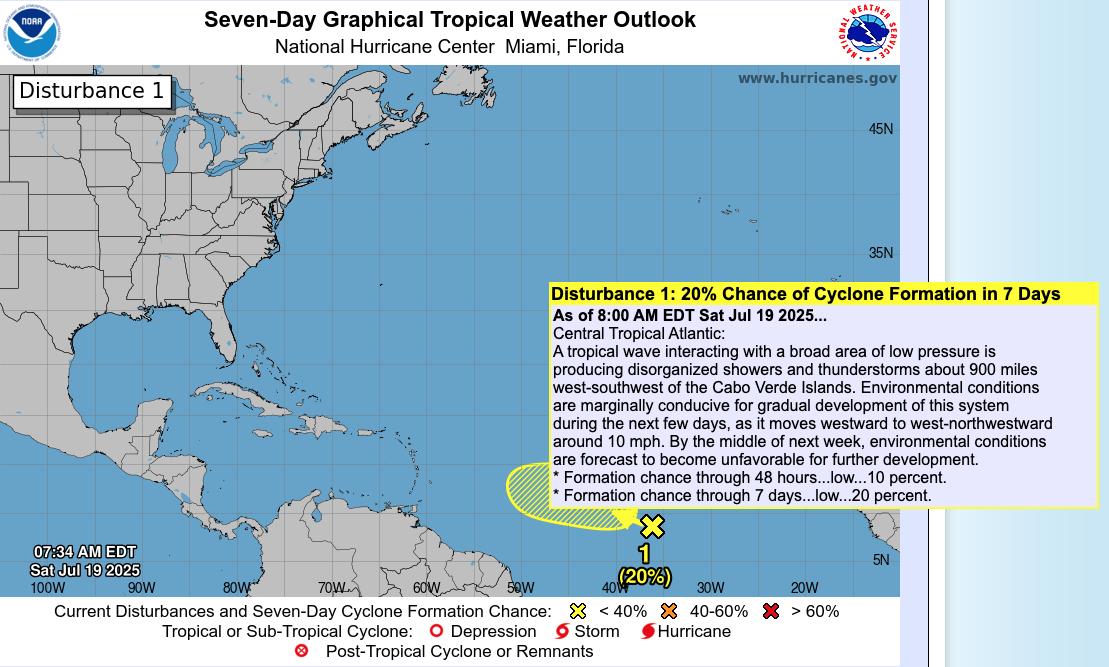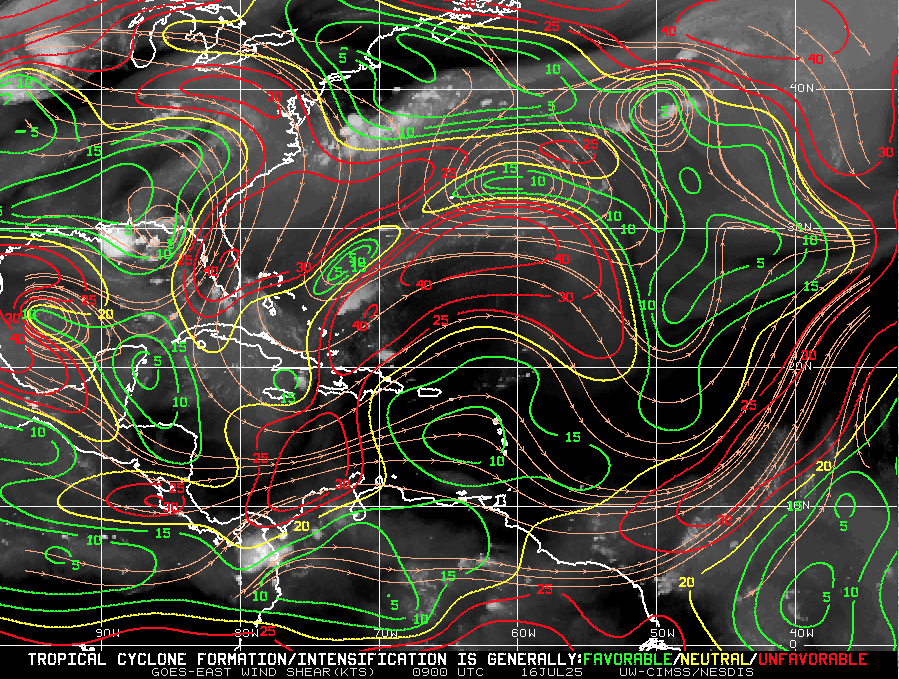Atlantic Hurricane Outlook – August 8, 2025: Dexter Is Now Post-Tropical; Invest 96L Gains Strength
Post-Tropical Cyclone Dexter exits the Atlantic, while Invest 96L shows increasing potential for tropical development. Conditions remain favorable with record-warm waters and weakening Saharan dust.
Post-Tropical Cyclone Dexter is moving off into the North Atlantic, fully transitioning into an extratropical system. Meanwhile, tropical wave Invest 96L in the central Atlantic now has a high chance of development, and another system further east offers mid-range development potential.
Atlantic Basin Overview
Dexter has become an expanded, post-tropical storm centered near 41.4° N, 50.4° W
—convection is waning and structure is elongated. (NHC advisory)Invest 96L (tropical wave near ~38° W):
Development chances now stand at 60% within 7 days. Recent observations show disorganized showers, but environmental trends suggest improved potential.New wave along ~38° W with an embedded 1011 mb low around 17° N:
Minimal convection currently, but models indicate conditions may become more favorable later this weekend.
—Chance of development: Low in 48 hours, medium in 7 days.
Environmental Conditions
Sea Surface Temperatures (SSTs): Remain strongly elevated—2–4 °F above average, with localized hotspots reaching 90 °F—offering ample fuel for future storm growth.
Wind Shear: Still moderate to high in the central tropical Atlantic; however, models suggest gradual easing may occur later in the month.
Saharan Air Layer (SAL): Though dust continues to suppress early-season convection, its influence is weakening, particularly in the western basin.
Dust & SAL data from Windy.com
Gulf & Caribbean Update
No tropical activity present.
A high-pressure ridge maintains calm, dry conditions across both regions, with only typical late-summer showers in coastal zones.
GOES-19 - Sector view: Gulf of America
GOES-19 - Sector view: Caribbean
Florida Forecast
Highs: Near 90 °F, with sticky, humid air.
Rain: 40–50% chance of afternoon thunderstorms driven by sea breezes.
Winds: Light and variable; no tropical weather expected.
Rain forecast visualization courtesy of Windy.com
Prep Tip of the Day
With Invest 96L showing increasing organization potential, now is an excellent time to check:
Hurricane supply kits
Evacuation plans
Emergency alert systems across your household
TL;DR – August 8 Snapshot
Dexter has become post-tropical—no land threat.
Invest 96L: 60% chance of development over the next week.
Another eastern wave: Low immediate risk, medium chance in 7 days.
SSTs warm, SAL draining, shear easing—conditions veering toward more activity.
Stay tuned—peak season is ramping up quickly.
For daily updates, stay locked to Cat5Prep.com.
Atlantic Hurricane Outlook – August 7, 2025: Dexter Becomes Extratropical; Invest 96L Watches Intensify
Tropical Storm Dexter is fading, but Invest 96L is strengthening in the Atlantic with a 60% development chance. Meanwhile, another Gulf disturbance lingers. Get the latest real-time update.
Tropical Storm Dexter is nearing its transition into a post-tropical system over the North Atlantic, while a tropical wave designated Invest 96L is gaining strength and has a high potential to develop over the coming days.
Atlantic Basin Summary
Tropical Storm Dexter has sustained winds near 50 mph and is centered around 40.6°N 52.1°W. It's moving east-northeast at approximately 18 mph and is expected to become a strong extratropical low within the next several hours.
Invest 96L, a tropical wave in the eastern Atlantic, now carries a 60% chance of developing into a tropical depression or storm within seven days. It's gaining better organizational structure amidst gradually supportive conditions.
A low-pressure area offshore of the Southeast U.S. retains a 30–40% development chance over the week, but is expected to remain well off the coast and should not pose a land threat.
Key Environmental Conditions
Sea Surface Temperatures (SSTs):
Waters across the Gulf, Caribbean, and Main Development Region remain 2–4°F above average, with locations near southwest Florida reaching nearly 90°F—providing abundant energy for storm formation.Wind Shear:
Wind shear is gradually easing, especially in the central and eastern Atlantic, offering more opportunities for systems like Invest 96L to organize further.Saharan Air Layer (SAL):
Dry and dusty SAL air still suppresses convection across parts of the basin, but its influence may be waning—especially in regions where moisture is increasing.Seasonal Context:
Meteorologists note an uptick in activity as August unfolds, in line with seasonal climatology and current environmental signals including marine heat waves.
Outlook Summary
Tropical Storm Dexter is at the tail end of its life cycle, now transitioning to an extratropical system. The main attention now shifts to Invest 96L, showing increasing potential for development, and a weaker disturbance offshore of the Southeast U.S.—both deserving close monitoring as we move further into the season.
TL;DR – August 7 Snapshot
Tropical Storm Dexter is becoming extratropical and poses no land threat.
Invest 96L carries a 60% chance of development this week.
Another disturbance offshore the Southeast U.S. has 30–40% development odds but remains away from land.
Warm ocean temperatures and easing shear are creating a more favorable environment.
The active season is ramping up—stay prepared and stay tuned.
Atlantic Hurricane Outlook – August 6, 2025: Dexter Weakens Over Open Atlantic; Two Systems Now Under Watch
Tropical Storm Dexter continues weakening in the open Atlantic, while two systems—off the Southeast U.S. coast and near Africa—are now under watch. SAL and wind shear are still limiting major development, but warm SSTs raise future potential.
*Those who like data, continue reading. Those it prefer the quick version, jump to the TL;DR here.
Tropical Storm Dexter continues moving northeast and weakening, while the National Hurricane Center is now monitoring two additional disturbances—one off the Southeast U.S. coast and another tropical wave across the eastern Atlantic—with modest development potential over the coming week.
Atlantic Basin Status
Tropical Storm Dexter is currently well north of Bermuda, sustained winds near 40–45 mph, moving east-northeast at ~13 mph. It's expected to transition to a post-tropical cyclone by mid-week and present no threat to land.
Disturbance near Southeast U.S. coast (“Invest AL95”): Located offshore of Florida, now has a 40% development chance over the next 7 days. While significant intensification is unlikely, it may bring increased rain and marine impacts along the Mid-Atlantic and Southeast coastal areas.
Tropical wave near ~30°W off Africa: Moving west-northwest, scattered convection observed. NHC assigns a 50% chance of development within 7 days, as it enters warmer seas and potentially weaker shear zones.
Key Environmental Conditions
Sea Surface Temperatures (SSTs): Gulf and Caribbean waters remain very warm (29–31 °C), offering the thermal fuel necessary for storm development as conditions evolve.
Wind Shear: Moderate to high shear prevails across much of the central Atlantic, limiting organization of existing systems. Models hint that shear may ease near the western MDR later this month.
Saharan Air Layer (SAL): A dry, dusty SAL plume still covers much of the eastern and central Atlantic, suppressing mid- to upper-level moisture and inhibiting thunderstorm persistence.
Atmospheric Moisture: Improving across the western basin, especially near the Caribbean, though heavy dry air remains in many parts of the Atlantic.
Gulf & Caribbean Update
No disturbances in the Gulf or Caribbean seas.
High-pressure dominance maintains generally dry conditions, with scattered showers typical of early August.
Expect stable marine conditions without organized tropical activity.
GOES-19 - Sector view: Gulf of America - Sandwich
GOES-19 - Sector view: Caribbean - Sandwich
Florida Forecast
Temperature & Humidity: Highs near 90°F under humid, muggy conditions.
Rain Chances: 40–50% for afternoon thunderstorms powered by sea breeze activity—not tropical in nature.
Winds: Light and variable inland, becoming southeast near the coast.
No tropical threats are expected to impact Florida today.
Rain forecast visualization courtesy of Windy.com
Prep Tip for the Day: Monitor Beach & Marine Conditions
Though Dexter is offshore, it is generating dangerous rip currents along the U.S. East Coast—from Florida through New England. Stay behavior-aware and heed coastal safety warnings even without landfall forecast.
Outlook
Dexter is weakening but remains watchable over open waters. The disturbance off Florida and the wave from Africa are the two main areas of tropical interest, each with moderate development odds this week. Persistent SAL and shear are still limiting, but conditions may shift toward favorability as August evolves.
TL;DR – August 6 Summary
Dexter weakening, staying over the open Atlantic.
Disturbance near Florida coast: 40% chance of development, may bring rain and marine effects.
Wave off Africa (~30°W): 50% development odds in 7 days.
Warm SSTs support activity, but SAL and wind shear remain inhibitory.
No immediate threats to Florida; hazardous rip currents possible.
Watch conditions as hurricane season builds toward mid‑August.
Stay prepared and stay informed — daily updates available at Cat5Prep.com.
Atlantic Hurricane Outlook – August 3, 2025: Two Areas Now Under Watch
The Atlantic remains calm with no named storms, but two areas—one off the U.S. coast and another off Africa—are now under watch for potential tropical development. Here's today's scientific hurricane outlook.
*Those who like data, continue reading. Those it prefer the quick version, jump to the TL;DR here.
As early August continues, the Atlantic remains without any active tropical cyclones. However, two areas have emerged as brown disturbance watches, as forecasters monitor subtle signs that could impact the Atlantic if conditions shift.
Atlantic Basin Highlights
No active tropical storms in the basin.
Two areas are now under National Hurricane Center scrutiny:
Invest Area AL95: Expected to be a fish storm, it’s a non-tropical low just off the North Carolina coast—producing disorganized thunderstorms. (The orange X on the chart)
➤ Chance of development: Medium (30%) over the next 2–7 days.
➤ Movement: Toward the east-northeast at ~10 mph, expected to stay offshore.Emerging tropical wave off Africa: Near 30°W, forecast to move westward with scattered convection.
➤ Chance of development: Low (30%) within 7 days.
GOES-19 - Sector view: North Atlantic - Sandwich - August 3, 2025
GOES-19 - Sector view: Tropical Atlantic - Sandwich - August 3, 2025
Key Environmental Conditions
Sea Surface Temperatures (SSTs):
The Gulf of Mexico and Caribbean Sea remain very warm, with temperatures ranging from 29–31°C (84–88°F). The Main Development Region (MDR) is also running slightly above average. These warm waters provide abundant fuel for tropical development — if other atmospheric factors allow.Wind Shear:
Moderate to high vertical wind shear persists across the central Atlantic, particularly along the latitude band where Disturbance 2 is located. This disrupts the vertical alignment of developing systems and limits the ability of convection to consolidate around a center.Moisture:
Mid-level moisture is gradually increasing across the western tropical Atlantic and Caribbean. However, the central Atlantic remains drier overall, especially in areas affected by Saharan dust, limiting deep convection and thunderstorm persistence.Saharan Air Layer (SAL):
A robust SAL is sweeping across the central and eastern Atlantic, characterized by dry, dusty air and suppressed vertical motion. The SAL also contributes to a stable atmosphere, effectively capping thunderstorm development and working against tropical wave organization.
Implication for Disturbance 2:
While ocean temperatures are favorable, the combined influence of high wind shear, limited moisture, and widespread SAL intrusion is expected to stall or inhibit further development of Disturbance 2 as it continues westward across the tropical Atlantic. Until it reaches a more favorable environment, organization remains unlikely.
Gulf of America (Mexico) & Caribbean Region
No disturbances active in the Gulf, and high-pressure conditions support light winds and minimal rain outside normal sea‑breeze showers.
Eastern Caribbean: A wave near 68°W is producing localized storms over Hispaniola and Venezuela but remains disorganized.
GOES-19 - Sector view: Gulf of America - Sandwich - August 3, 2025
GOES-19 - Sector view: Caribbean - Sandwich - August 3, 2025
Florida Weather Outlook
Highs: Near 90 °F under sticky, humid conditions.
Conditions: Scattered afternoon thunderstorms from sea breeze interactions.
No tropical impacts expected today.
Rain forecast visualization courtesy of Windy.com
Prep Tip of the Day: Know Your Warning Signals
Test your alert systems today:
Confirm subscription to NOAA alerts and local county emergency systems.
Test NOAA weather radios and storm tracker apps.
Make sure household members know hurricane communication plans and locations of essential documents.
Outlooking Ahead
Invest Area AL95, while moving away from land, bears watching if it gains tropical characteristics. Meanwhile, the wave off Africa will pass into warmer waters—another early‑August indicator. Meteorological models forecast these systems might strengthen if wind shear declines and dust regresses later this month.
TL;DR – August 3 Hurricane Summary
No storms currently in the Atlantic basin.
AL95 (off North Carolina): 30% chance of development over the next week. (Fish Storm)
African wave near 30°W: 20% chance of development within 7 days.
Factors are currently favoring disorganization.
SSTs are warm and moisture is increasing—conditions may improve in early August.
Immediate risk remains low; now is a good window for storm preparedness.
Stay alert and ready with daily forecasts at Cat5Prep.com.
Atlantic Hurricane Outlook – August 2, 2025: Watching Waves, But No Storms Expected
The Atlantic remains calm to start August, with no storms expected this week. A few tropical waves are being monitored, but dry air and wind shear continue to suppress development—for now.
*Those who like data, continue reading. Those it prefer the quick version, jump to the TL;DR here.
As we settle into early August, the Atlantic remains quiet—no active tropical systems and no development forecasted over the next seven days. Although several tropical waves continue moving westward, persistent upper-level wind shear and Saharan dust limit their potential for organization.
Atlantic Basin Summary
Latest NHC Tropical Weather Scales:
The 8 AM EDT Tropical Weather Outlook confirms no systems expected to form within seven days.
Multiple tropical waves are active:
A wave near 43–50°W with scattered convection.
A new wave moving off Africa near 30°W, gradually tracking westward.
None display organized circulation or development potential at this time.
Satellite imagery provided by Windy.com
Environmental Conditions
Sea Surface Temperatures (SSTs):
29–31 °C (84–88 °F) across the Gulf of Mexico and Caribbean.
MDR temperatures remain slightly above average, offering rising energy for late-season storms.
Wind Shear:
Still moderate to high across much of the basin, inhibiting vertical growth.
Saharan Air Layer (SAL):
Thick dry air layer continues across most of the MDR, suppressing convection and storm development.
Atmospheric Moisture:
Gradually increasing in the western Atlantic and Caribbean—monitoring for signs of improved convective support.
Gulf of America (Mexico) & Caribbean Region
No disturbances currently monitored.
A dominant high-pressure ridge maintains light winds and calm seas.
Scattered showers along Florida’s west coast remain typical summer moisture—not tropical in origin.
Radar imagery courtesy of Windy.com
Florida Forecast
Highs: Upper 80s to low 90s °F with high humidity.
Rain Chances: 40–50% for scattered afternoon thunderstorms due to seabreeze convergence.
Winds: Light and variable.
No tropical threats expected in Florida today.
Rain forecast visualization courtesy of Windy.com
Seasonal Outlook
The Atlantic season to date includes three named storms (Andrea, Barry, and Chantal), but lacks any hurricanes—a below-average ACE, echoing early-season inactivity last seen in 2009.
NOAA and CSU continue to forecast above-average hurricane activity overall, with 13–19 named storms and 6–10 hurricanes anticipated this season.
August typically marks the ramp-up of tropical activity, especially across the MDR and Gulf of Mexico, where conditions may become more favorable by mid-month.
Prep Tip of the Day: Verify Your Alert Setup
Now is a good time to:
Confirm you’re registered with local emergency alert systems.
Test NOAA weather radios and app notifications.
Re-check family communication plans and emergency kit locations.
Looking Ahead
While the forecast remains calm now, early August often brings the first major shifts in seasonal activity. Keep tracking tropical waves as they approach warmer waters and potentially lower shear environments.
TL;DR – August 2, 2025 Hurricane Summary
No active storms or developing systems in the Atlantic.
Several tropical waves are present but remain weak and disorganized.
High wind shear and Saharan dust continue to suppress development.
Sea surface temperatures are high and rising.
Historical patterns suggest increased activity may begin in mid‑August.
Stay prepared and stay informed with daily updates from Cat5Prep.com.
Atlantic Hurricane Outlook – July 31, 2025: Tropics Active But No Storms on the Horizon
Tropical waves continue to move across the Atlantic, but none show signs of organization. Saharan dust and wind shear are keeping storm development in check—for now.
*Those who like data, continue reading. Those it prefer the quick version, jump to the TL;DR here.
The Atlantic basin continues to host several tropical waves—but none are expected to organize into tropical cyclones over the next seven days. Despite warm seas and increasing moisture, wind shear and Saharan dry air maintain a suppressive environment.
Atlantic Basin Summary
As of the 8:00 AM EDT Tropical Weather Outlook (TWO) from the National Hurricane Center, there are:
No active tropical cyclones.
No areas under investigation for development in the next 48 hours or seven days.
The Tropical Weather Discussion (issued at ~12:15 UTC) reveals:
A tropical wave near 43°W (south of 22°N) moving westward at 10–15 kt, with scattered moderate convection between 4–10°N.
Another wave near 55°W (south of 18°N) moving west at about 10 kt, with minimal convection.
These waves are being monitored but show no organized structure or circulation at present.
Key Weather Factors
Sea Surface Temperatures (SSTs):
Across the Gulf of Mexico, Caribbean, and MDR, SSTs range from 29–31 °C (84–88 °F)—values supportive of tropical development if atmospheric conditions improve.
Wind Shear:
Remains moderate to high across most of the Atlantic basin, limiting vertical development of disturbances.
Saharan Air Layer (SAL):
Dry and dusty air persists across the central and eastern Atlantic, suppressing convection in the MDR.
Atmospheric Moisture:
While moisture is gradually increasing near the Caribbean and western tropical Atlantic, the dry air and shear continue to hinder system organization.
Gulf of America (Mexico) & Caribbean Region
No low-pressure areas or disturbances are being tracked.
A dominating high-pressure ridge supports generally light winds and calm seas across the Gulf and Caribbean.
Offshore rainfall remains typical for this time of year—no tropical impacts on the Florida peninsula.
GOES-19 - Sector view: Gulf of America - Sandwich
GOES-19 - Sector view: Caribbean - Sandwich
Florida Forecast
High temperatures: Near 90 °F under humid conditions.
Afternoon showers and thunderstorms: 40–50% likelihood due to sea breeze convergence.
Winds: Light and variable inland; east-southeasterly along the coast.
Precipitation: Not driven by tropical systems.
Rain forecast visualization courtesy of Windy.com
Preparation Tip: Review Your Evacuation Plan
Take advantage of the lull to finalize your hurricane readiness:
Verify evacuation zones and travel routes.
Confirm alert registration with local and state emergency systems.
Update contact information and checklist locations with household members.
Outlook & Future Signal
Although today’s conditions remain tranquil, the ongoing wave train emerging from Africa and gradually improving moisture and SST profiles suggest that rainfall and organization potential may increase in early August.
TL;DR – July 31, 2025 Snapshot
No tropical systems present.
Two tropical waves travel west, but show none of the structure needed for development.
Strong wind shear and Saharan dust continue to suppress storm formation.
Warm waters and increased moisture hint at higher activity potential in August.
Stay informed and prepare while the pace allows. Daily updates continue at Cat5Prep.com.
Atlantic Hurricane Outlook – July 30, 2025: Development Chances Remain Low
As July ends, the Atlantic Basin sees active tropical waves, but development chances remain low for the next 7 days. Discover the latest on sea surface temperatures, wind shear, Saharan Air Layer, and the outlook from CAT5Prep.com.
*Those who like data, continue reading. Those it prefer the quick version, jump to the TL;DR here.
** Due to technical issues on the GOES satellite imagery provider's end, we are currently unable to display real-time satellite imagery.
The Atlantic Basin remains active with multiple tropical waves stretching from the African coast to the Caribbean, yet no organized development is expected in the near term. Wind shear and Saharan dust continue to suppress cyclone formation despite warm ocean temperatures and a moistening atmosphere in the western basin.
As we close out July, conditions are slowly trending toward a more favorable setup for storm development heading into August.
Atlantic Basin Overview
As of the 8:00 AM EDT NHC Tropical Weather Outlook:
No active tropical cyclones.
Three tropical waves span the Atlantic:
Wave near 35°W (eastern Atlantic): Disorganized, little convection.
Wave near 50°W (central Atlantic): Producing scattered thunderstorms, no surface low.
Wave in the eastern Caribbean: Weak and encountering dry air and shear.
NHC Development Odds:
Next 48 hours: 0%
Next 7 days: 0%
Key Environmental Factors
SST data courtesy of Windy.com
Wind data at 850hPa from Windy.com
Sea Surface Temperatures (SSTs):
29–31°C (84–88°F) in the Gulf of Mexico and Caribbean.
MDR remains slightly warmer than normal.
Wind Shear:
Moderate across the central Atlantic and Caribbean.
Suppressing vertical development for now.
Saharan Air Layer (SAL):
Strong dry air across much of the basin.
Limiting convection and keeping tropical waves disorganized.
Moisture:
Gradually increasing in the western Atlantic and Caribbean.
A factor to monitor as wind shear begins to ease.
Gulf of Mexico (Gulf of America)
A weak surface trough in the central Gulf is producing scattered showers and isolated thunderstorms.
No signs of organization, and the NHC does not expect development at this time.
High pressure remains dominant elsewhere, with calm conditions expected through midweek.
Florida Weather
Highs in the upper 80s to low 90s with high humidity.
Scattered thunderstorms possible in the afternoon and evening from sea breeze interactions.
No tropical threats to Florida at this time.
Radar imagery courtesy of Windy.com
Outlook & Preparedness
The Atlantic remains broadly quiet for now, but the environment is slowly shifting. A steady wave train emerging off Africa and increasingly favorable SSTs point to a more active window in early to mid-August.
Now is the time to double-check hurricane kits, review evacuation zones, and prepare while the weather allows.
TL;DR – July 30 Snapshot
No tropical development expected this week.
Three tropical waves are present but remain weak and disorganized.
SAL and shear are limiting development.
Conditions should become more favorable by early August.
Atlantic Hurricane Outlook – July 19, 2025: Disturbance in the Deep Tropics Eyes Development
A tropical wave southwest of the Cabo Verde Islands shows a low chance of development as it moves westward. Conditions remain mixed across the Atlantic, but signs of activity are increasing.
The Atlantic Basin remains relatively quiet today, but there’s a new player on the map. A tropical wave in the central tropical Atlantic—labeled Disturbance 1—has a low but notable chance of development over the next week. This marks the first sign of deeper tropical activity emerging from the Main Development Region (MDR) as we move closer to peak hurricane season.
Atlantic Basin Overview: One Area to Watch
As of 8:00 AM EDT Saturday, July 19, 2025, the National Hurricane Center is monitoring:
No named tropical cyclones
One disturbance in the central Atlantic
Tropical development chances:
10% over 48 hours
20% over 7 days
Disturbance 1 is a tropical wave located about 900 miles west-southwest of the Cabo Verde Islands, interacting with a broad area of low pressure. Showers and thunderstorms remain disorganized, but marginally favorable conditions could support slow development as the system moves west to west-northwest around 10 mph.
However, by mid-week, environmental conditions are expected to become less favorable, limiting its window for intensification.
Satellite imagery courtesy of Windy.com
Sea Surface Temperatures: Fuel in Place
Waters remain very warm across much of the Atlantic:
Gulf of Mexico: Holding above 86°F (30°C) in many areas
Western Caribbean: High SSTs remain steady
Main Development Region (MDR): Warm enough to support tropical wave development—an important factor as more systems emerge off Africa
These warm waters are key to supporting systems like Disturbance 1.
Sea Surface Temperature data courtesy of Windy.com
Wind Shear & Moisture: Still Mixed
Wind Shear: Moderate in the eastern Atlantic near Disturbance 1 but lower closer to the Caribbean
Moisture: Rising across the western Atlantic, but dry air from the Saharan Air Layer (SAL) is still suppressing deeper convection across much of the MDR
While the disturbance has some support for development, these mixed upper-atmospheric conditions could limit growth.
Wind Shear Courtesy of https://tropic.ssec.wisc.edu/
Relative Humidity (ECMWF) data courtesy of Windy.com
Saharan Air Layer: Still an Inhibitor
Dry, dusty air continues to stretch across much of the central and eastern Atlantic. It:
Reduces storm cloud organization
Increases atmospheric stability
Weakens convection associated with tropical waves
SAL is expected to persist into early August but may begin to recede gradually.
Saharan Air Layer (Dust) data courtesy of Windy.com
Thunderstorm Activity: Isolated and Mostly Local
Florida: Scattered PM thunderstorms expected—typical for this time of year
Gulf & Western Caribbean: Moisture lingers but no signs of tropical organization
Off Africa/Central Atlantic: Activity is tied to Disturbance 1, but convection remains weak
Thunderstorm forecast (ECMWF) courtesy of Windy.com
Florida Forecast
Highs: Upper 80s to low 90s
Humidity: High
Rain: Isolated to scattered afternoon storms
Winds: Light to moderate easterlies
Rainfall forecast (ECMWF) courtesy of Windy.com
Prep Tip of the Day: Know the Early Signs
With deeper Atlantic activity beginning, now is a good time to refresh your awareness:
Follow NHC's five-day outlooks
Understand what “low chance” really means—it can change fast with heat and time
Review your emergency communication plan and make sure alerts are enabled
Looking Ahead: Watch the MDR
While Disturbance 1 may or may not develop, its emergence from the Cabo Verde region is a signal that the deep tropics are beginning to stir. Expect more waves in the coming weeks as we approach the climatological ramp-up of hurricane season.
Stay informed. Stay ready. Your next real-time update comes tomorrow from Cat5Prep.
Atlantic Hurricane Outlook – July 16, 2025: Gulf Disturbance Lingers, Tropics Stay Quiet
A weak low in the Gulf of Mexico brings rain and storms to Florida, but no tropical development is expected. Cat5Prep’s daily update covers real-time conditions, SSTs, and what to watch next.
The Atlantic hurricane basin remains quiet in terms of named storms, but attention continues to center on a weak low-pressure system lingering over the eastern Gulf of Mexico. Although this system remains disorganized and development chances are low, it’s bringing widespread showers and thunderstorms across parts of Florida, the northeastern Gulf, and coastal Georgia.
While no tropical development is expected over the next 7 days, the broader environment is slowly shifting toward favorability, with rising sea surface temperatures, weakening wind shear, and the gradual retreat of the Saharan Air Layer (SAL).
Atlantic Basin Overview
As of the latest NHC update (2:00 PM EDT):
No active tropical cyclones
One disturbance in the Gulf of Mexico (Low development chance)
No tropical formation expected in the next 7 days
Satellite imagery courtesy of Windy.com
Disturbance in the Gulf of Mexico
A broad area of low pressure continues to meander just west of Florida over the northeastern Gulf of Mexico:
Development chances remain low (0% over 48 hours, 10% over 7 days)
System remains non-tropical and disorganized
Producing periods of heavy rainfall, especially across the Florida Panhandle, southern Georgia, and coastal South Carolina
Some gusty winds and isolated flooding may occur, especially in areas with poor drainage
This system is expected to drift inland by late Thursday, reducing any tropical potential.
Radar imagery courtesy of Windy.com
Sea Surface Temperatures (SSTs)
Ocean temperatures remain exceptionally warm, providing high potential energy for storm development once other conditions align:
Gulf of Mexico: 86–89°F (2–4°F above normal)
Western Caribbean: 85–88°F
Main Development Region (MDR): Now reaching 82–84°F across much of the eastern Atlantic
Sea Surface Temperature data courtesy of Windy.com
Atmospheric Conditions
Wind Shear Courtesy of https://tropic.ssec.wisc.edu/
Wind Shear: Still elevated in the western Atlantic and Gulf, but beginning to weaken, particularly near Central America and the western Caribbean.
Moisture: Mid-level moisture continues to increase, especially in the Caribbean and southern Gulf.
Saharan Air Layer: A large, dry SAL continues to stretch across the central Atlantic, suppressing storm formation east of the Lesser Antilles, but it's expected to weaken by early August.
Relative Humidity (ECMWF) data courtesy of Windy.com
Saharan Air Layer (Dust) data courtesy of Windy.com
Thunderstorm & Rainfall Activity
Florida & Gulf Coast: Expect locally heavy rain and thunderstorm clusters tied to the Gulf disturbance.
Western Caribbean: Some disorganized convection continues, but nothing tropical at this time.
West Africa: A new tropical wave has emerged, but faces significant dry air and shear over the central Atlantic.
Rainfall forecast (ECMWF) courtesy of Windy.com
Florida Forecast
Highs: Upper 80s to low 90s°F
Humidity: High, with a heat index reaching the upper 90s
Rain: 60–70% chance of scattered storms in parts of Florida, especially in the afternoon and evening
Winds: Light southeast winds, with occasional gusts during storms
Prep Tip of the Day: Review Flood Insurance Coverage
Standard homeowners insurance does not cover flood damage. Use this calm window to:
Check your flood zone designation
Review your current policy limits
Confirm your coverage start date (flood insurance usually has a 30-day waiting period)
With warm SSTs and an increasingly favorable atmosphere, inland and coastal flood risk rises as we move deeper into hurricane season.
Looking Ahead: Watchful, Not Worrying
Although July 16 brings no immediate storm threats, all eyes remain on the broader Atlantic:
The ingredients for development are aligning: warm water, weakening shear, and increased moisture.
The next two weeks may see the first organized systems forming in the western Caribbean or Gulf of Mexico.
Now is the time to stay informed and finalize preparations—not when a storm is already on the map.
Atlantic Hurricane Outlook – July 15, 2025: Gulf System Organizing, Tropics on Alert
A weak low over Florida is drifting into the Gulf of Mexico, producing heavy rain and prompting close monitoring. While development chances remain low, record-warm waters and shifting winds suggest more activity is coming.
The Atlantic remains officially quiet, but eyes are turning toward the Gulf of Mexico as a broad area of low pressure continues to develop. Though not yet a tropical depression, this system is producing heavy rainfall across parts of Florida and may slowly organize over the next few days. Elsewhere, warm sea surface temperatures and improving atmospheric conditions continue to set the stage for increased activity as July progresses.
Atlantic Basin: Watching the Gulf
As of this morning’s update from the National Hurricane Center (NHC):
No named tropical cyclones
One area of interest: Disturbance near Florida
Development potential: Low over 48 hours (10%), Slightly higher over 7 days (20%)
A broad, weak surface trough stretching across southern Florida is generating scattered storms and heavy rainfall. As it drifts westward into the Gulf of Mexico, slight development is possible—though wind shear and dry air may continue to limit its growth in the near term.
Regardless of tropical classification, this system is expected to bring:
Heavy rainfall across Florida and the Gulf Coast
Localized flash flooding
Coastal thunderstorms and rough surf
Satellite imagery courtesy of Windy.com
Sea Surface Temperatures: Primed and Warming
Waters across much of the Atlantic basin are running well above average:
Gulf of Mexico: 87–89°F (30–32°C) across much of the basin—ideal for storm formation
Caribbean Sea: Persistently warm, with temperatures near or above 86°F (30°C)
Main Development Region (MDR): Trending well above average for mid-July
This level of ocean heat content supports rapid intensification potential for any system that organizes in the coming weeks.
Sea Surface Temperature (ECMWF Analysis) courtesy of Windy.com
Atmospheric Conditions: Becoming More Favorable
Wind Shear Courtesy of https://tropic.ssec.wisc.edu/
Wind Shear: Moderate across the Gulf and Caribbean, but forecast models show a gradual easing through late week
Moisture Levels: Improving, especially in the western Caribbean and southern Gulf
Upper-Level Winds: Starting to show a less hostile pattern over the Gulf and MDR
Overall, the atmospheric profile is trending toward neutral to favorable—a subtle but important change.
Relative Humidity data (ECMWF) courtesy of Windy.com
Saharan Air Layer (SAL): Retreating Slowly
Dry air remains across parts of the eastern Atlantic but is beginning to loosen its grip:
Still suppressing deep convection off the African coast
Expected to retreat westward and weaken through the next 7–10 days
This transition opens the door for tropical waves to survive and organize
Saharan Air Layer (Dust) data courtesy of Windy.com
Florida & Gulf Coast Forecast: Wet and Stormy
The disturbance currently over Florida is impacting much of the region:
Florida Peninsula
Scattered to widespread showers and storms today
Localized flooding possible, especially in urban areas
Highs in the upper 80s to low 90s°F
Northern Gulf Coast (AL/MS/FL Panhandle)
Cloudier skies and increasing storms through tomorrow
Elevated rainfall totals possible
Winds 10–20 mph with gusty thunderstorms
Radar imagery courtesy of Windy.com
Prep Tip of the Day: Secure Outdoor Items
With storms increasing across the Southeast:
Bring in or secure loose outdoor items like patio furniture, garden tools, and trash bins
Clear storm drains and gutters to reduce urban flooding risk
Monitor flash flood alerts in flood-prone neighborhoods
Looking Ahead: A Pattern Shift Is Coming
Although no named systems are expected in the next few days, the Gulf disturbance is a reminder that even weak systems can cause significant impacts. Sea surface temperatures and weakening wind shear are setting the table for development in the latter half of July.
Stay tuned, stay prepared, and check back daily with Cat5Prep for accurate, actionable updates.
Atlantic Hurricane Outlook – June 20, 2025: Tropics Hold Quiet as Atlantic Patterns Begin to Shift
The Atlantic remains calm with no storms expected, but warm waters and shifting atmospheric patterns hint that the quiet may not last. A developing Atlantic Niña could hit a reversal and amplify activity later this season.
As we close out the third week of the 2025 Atlantic hurricane season, the basin remains quiet. No named storms or tropical disturbances are being monitored by the National Hurricane Center (NHC), and no development is expected over the next 7 days. However, behind this calm lies a subtle shift in Atlantic patterns that may influence storm activity in the weeks ahead.
Atlantic Basin: All Clear—for Now
As of the latest NHC update (8 AM EDT, June 20):
No active tropical cyclones
No areas of interest
No tropical development expected through late June
This type of quiet is typical for mid-June, historically a transitional period before activity ramps up in July and peaks from August to October.
Satellite view via Windy.com
Sea Surface Temperatures: Still Hot, Still Fuel
Sea surface temperatures (SSTs) across much of the Atlantic remain well above normal:
Gulf of America (Mexico): Mid to upper 80s°F (29–31°C), 2–4°F above average
Western Caribbean: Similar anomalies, particularly near the Yucatán and Cuba
Main Development Region (MDR): Still warming gradually, trending toward conditions that could support long-track storms later this season
Warm SSTs are a critical energy source for hurricanes—and the heat is already in place.
Sea Surface Temperature (ECMWF Analysis) via Windy.com
Atmospheric Conditions: Neutral ENSO, but Atlantic Cooling Briefly
While the Pacific remains in an ENSO-neutral phase, a rare “Atlantic Niña” has recently emerged—marked by cooler-than-average sea surface temperatures in the eastern tropical Atlantic off the coast of Africa, as seen in the NOAA Coral Reef Watch chart below with a pocket of blue.
This can temporarily suppress early-season hurricane formation by reducing convection and stabilizing the atmosphere
However, models indicate that this pattern may reverse in July, shifting into a warmer Atlantic Niño phase, which typically boosts tropical activity
So, while the Atlantic Niña may be limiting development now, forecasters are closely watching the timing of this transition. Safe money would be on a reversal, which could super charge storm breeding.
Overall Scope of Sea Temperature Anomalies
Saharan Air Layer: Still Limiting Tropical Waves
Wind Shear Courtesy of https://tropic.ssec.wisc.edu/
A strong Saharan Air Layer (SAL) remains entrenched across the tropical Atlantic:
Dry, dusty air suppresses thunderstorm development
Increases stability and upper-level wind shear
Common in June, but typically weakens by mid-July
For now, SAL continues to act as a shield against organized tropical development in the Main Development Region.
Saharan Air Layer (Dust) data via Windy.com
Thunderstorm Activity: Mostly Seasonal and Local
While no tropical organization is underway, convection continues to pop up in key regions:
Florida and Gulf Coast: Afternoon storms due to heat and humidity
Western Caribbean: Scattered convection, but unorganized
Eastern Atlantic: A few tropical waves exiting Africa remain weak and embedded in dry air
These thunderstorms are typical for the season and do not currently show signs of tropical development.
Thunderstorm Forecast (ECMWF) via Windy.com
Florida Forecast
Highs: Upper 80s to low 90s°F (31–33°C)
Humidity: High
Afternoon Storms: Scattered area of thunderstorms likely after 2 PM
Winds: Light and variable, with storm gusts possible
Flooding in low-lying areas is possible if storms linger over one area.
Rainfall Forecast (ECMWF) via Windy.com
Prep Tip of the Day: Restock Pet Supplies
Don’t forget your furry family members when preparing for hurricane season:
Have a two-week supply of pet food, medications, and water
Keep vaccination records and vet contact info in your go-bag
Prepare a small pet first-aid kit
Label pet carriers clearly and store them where they’re easy to grab
Looking Ahead: Transition Coming
For now, the Atlantic basin is calm. But forecasters continue to watch:
Warm SSTs
Easing wind shear
Gradual return of moisture
Potential reversal from Atlantic Niña to Atlantic Niño
All signs point to a more active environment forming as we move into July. Stay alert, stay prepared, and check back tomorrow for your daily hurricane outlook from Cat5Prep.com.
Atlantic Hurricane Outlook – June 19, 2025: Still Down South – Pacific Watches Erick
The Atlantic remains storm-free, but Hurricane Erick—a powerful Category 4 storm—gains strength in the Eastern Pacific. Learn what this means for the Atlantic basin and why now is the time to prepare.
The Atlantic basin remains quiet today, with no active tropical cyclones and no development expected over the next 7 days, according to the National Hurricane Center’s latest 2 AM and 8 AM EDT outlooks nhc.noaa.gov. While the Atlantic sleeps, attention is turning to a powerful system in the Pacific.
Atlantic Basin: Calm Waters, No Alerts
There are still no named storms or areas under tropical monitoring. The graphical and textual 7-day outlooks show zero development chance, meaning the basin continues its quiet stretch early in the season . Early June silence isn’t unusual—but with warm seas in place, conditions could shift quickly.
Satellite view via Windy.com
Pacific Perspective: Erick Now a Category 4
In the Eastern Pacific, Hurricane Erick has rapidly intensified into an “extremely dangerous” Category 4 storm with 145 mph sustained winds, now only about 70 miles west-southwest of Puerto Ángel, Mexico, heading for landfall.
This storm is expected to bring destructive winds, brutal rainfall (8–16 inches), mudslides, and severe coastal flooding across southern Mexico.
Sea Surface Temperatures: Atlantic Warming Continues
Gulf & Western Caribbean: SSTs remain warm at 84–88 °F, maintaining energy supply for potential tropical systems.
Main Development Region (MDR): Ocean temperatures are also above normal, setting the stage for Atlantic activity later in the season.
Sea Surface Temperature via Windy.com
Atmospheric Conditions: Suppressive Air Masses
Wind Shear Courtesy of https://tropic.ssec.wisc.edu/
Wind shear: Still moderate to high across key development areas, limiting near-term storm formation.
Saharan Air Layer (SAL): A persistent dust plume continues to suppress early-season activity in the eastern Atlantic.
Moisture: Slowly increasing in the Gulf and western Caribbean, helping build storm potential.
Saharan Air Layer (Dust) via Windy.com
Daily Weather: Standard June Patterns
Florida & Southeast U.S.: Afternoon and evening thunderstorms remain widespread but non-tropical.
Caribbean & Atlantic: Quiet and storm-free, with no signs of developing systems.
Air Quality: Possible haze in Florida due to advancing Saharan dust.
Thunderstorm Forecast (ECMWF) via Windy.com
Florida Forecast (June 19)
Highs: Upper 80s to low 90s °F (31–33 °C)
Humidity: High—typical muggy summer
Rain: Scattered PM showers and thunderstorms
Visibility: Hazy in some areas
Winds: Light, occasional gusts near storm cells
Rainfall Forecast (ECMWF) via Windy.com
Prep Tip of the Day: Cross-Basin Awareness
Even without Atlantic storms, Pacific activity underscores a critical point:
Monitor systems across basins, not just the Atlantic
Understand conditions building globally—warm seas, dust, wind shear shifts
Use this calm time to update emergency contacts, test NOAA radios, and finalize supply kits
Looking Ahead: Calm Now, But It Won’t Last
No Atlantic activity is expected this week, but elevated ocean temperatures, decreasing wind shear, and diminishing dust suggest a shift is coming. Hurricane Erick in the Pacific could hint at similar atmospheric boosts affecting the Atlantic soon.
Stay tuned for daily updates from Cat5Prep.com—the next tropical trigger could arrive sooner than you think.
Atlantic Hurricane Outlook – June 17, 2025: Tropics Remain Quiet Despite Peak Heat
The Atlantic basin remains calm with no tropical storms in sight, despite record ocean heat and widespread Saharan dust. Forecasters continue monitoring subtle environmental shifts that could drive activity later this month.
The Atlantic basin remains clear today, with no active tropical cyclones and no tropical development expected over the next seven days, according to the National Hurricane Center’s 2 AM EDT outlook. Despite intense heating of sea surfaces, climatic factors are currently suppressing system formation.
Atlantic Basin: Calm, But Conditions Are Charged
No tropical cyclones or disturbances are being monitored. The Atlantic basin is experiencing what experts are calling an “unusual lull”—something highlighted recently by the Houston Chronicle, which also noted the ongoing Saharan dust presence suppressing early-season activity.
Satellite view via Windy.com
Sea Surface Temperatures: Fuel Ripe, But Storms Dormant
Gulf of America (Mexico) & Western Caribbean: Waters are hovering near 2°F above average, reaching 84–88°F, akin to early June 2024—an impressively warm baseline for storm development.
Main Development Region (MDR): Also experiencing above-average SSTs, laying the groundwork for future storm growth, though not yet fueling storms.
Sea Surface Temperature via Windy.com
Atmospheric Dynamics: Still Holding Back Storms
Wind Shear Courtesy of https://tropic.ssec.wisc.edu/
Wind Shear: Remains moderate to high, hindering storm organization across key regions.
Mid-Level Moisture: Slowly increasing, which may support thunderstorm development—but conditions remain insufficient for cyclones.
Saharan Dust Layer: A steady plume of Saharan air continues to suppress convection, reinforcing atmospheric stability across the Atlantic.
Saharan Air Layer (Dust) via Windy.com
Thunderstorm Activity: Local Showers Only
Florida and much of the Southeast will experience typical midday and afternoon thunderstorms driven by summer heat—not tropical systems. The Caribbean and Atlantic remain clear, with no signs of cluster formation or rotation.
Thunderstorm Forecast (ECMWF) via Windy.com
Florida Forecast (Statewide Conditions)
Highs: Upper 80s to low 90s °F (31–33 °C)
Humidity: Rising—classic early-summer humidity
Rain: Scattered afternoon storms likely, locally intense but short in duration
Visibility & Air Quality: Possible haze from Saharan dust in some southern counties
Winds: Light and variable, with stronger gusts near storm cells
Rainfall Forecast (ECMWF) via Windy.com
Prep Tip of the Day: Dust Alert and Kit Check
Today’s calm weather can hide hidden risks from dust and heat. Take action:
Improve indoor air quality: change HVAC filters and open windows carefully
Wear masks or stay indoors if sensitive to dust
Check your hurricane supplies and evacuation plans
Ensure NOAA Weather Radio and mobile alerts are operational
Bookmark trusted sites, like Cat5Prep.com and hurricanes.gov
Looking Ahead: Quiet Doesn't Mean Safe
No tropical development is expected in the next week, but climatological factors suggest the lull is temporary. Warm ocean temperatures and increasing moisture may spark storm formation later in June. Monitor daily updates as conditions evolve.
Atlantic Hurricane Outlook – June 6, 2025: Quiet Tropics, No Development Expected
June 6, 2025: No named storms or tropical threats in the Atlantic basin today, but signs of change are emerging. Sea surface temperatures continue to climb, and wind shear may weaken in the coming weeks. Now’s the time to review your hurricane prep plan.
The 2025 Atlantic hurricane season continues with a calm week, as no tropical cyclones or areas of concern are present. The National Hurricane Center (NHC) confirms no tropical development is expected over the next seven days, marking a quiet yet cautious start to June.
Atlantic Basin: Clear Skies for Now
From the 8 AM EDT Tropical Weather Outlook issued June 6:
No active tropical cyclones
No areas of concern
No development expected in the next seven days
The NHC’s maps and guidance reflect this assessment, indicating a continued quiet period. Notably, previous offshore coastal disturbances have been dropped and are no longer being tracked.
Satellite imagery courtesy of Windy.com
Sea Surface Temperatures: Stable But Still Warm
Warm SSTs persist in regions key to hurricane development:
Gulf of America (Mexico) & Western Caribbean: Remain seasonally warm (low to mid-80s°F)
Main Development Region (MDR): Still trending above normal for early June
While SSTs provide essential fuel, other atmospheric factors currently suppress development.
Sea surface temperature data courtesy of Windy.com
Wind Shear & Moisture: Conditions Not Yet Favorable
Wind Shear: Moderate across much of the basin, particularly in the western Caribbean and central Atlantic
Atmospheric Moisture: Rising gradually, but not yet supportive of storm formation
These conditions reduce the likelihood of tropical development in the immediate future.
Wind Shear Courtesy of https://tropic.ssec.wisc.edu/
Saharan Air Layer: Suppression in Full Effect
A strong plume of Saharan dust continues to suppress Atlantic convection:
Dry air and elevated shear persist across the eastern tropical Atlantic and MDR apnews.com
The SAL remains a key barrier to any early-season system development
Expect this barrier to weaken later in June
Saharan Air Layer (SAL) dust data courtesy of Windy.com
Thunderstorm Activity: Localized, Non-Tropical
Florida & Southeastern U.S.: Scattered afternoon thunderstorms—normal for this season
Western Caribbean: Isolated, disorganized showers and storms with no rotation
Eastern U.S. Coast: No significant organized convection detected
These are routine summer thunderstorms—not tropical systems.
Thunderstorm forecast data courtesy of Windy.com
Florida Forecast: Typical Early Summer Conditions
Expect another classic June day:
Highs: Upper 80s to low 90s°F (31–33 °C)
Humidity: Moderate to high, creating muggy conditions
Rain: Scattered afternoon and evening showers likely
Winds: Light and variable
Rainfall forecast data courtesy of Windy.com
Prep Tip of the Day: Emergency Alerts and Insurance
Take advantage of today’s calm to:
Confirm your emergency alert subscriptions, including text and email
Review your insurance coverage and update policy details if needed
Gather digital and physical copies of critical documents
Familiarize yourself with evacuation zones in your area
Looking Ahead: Still Calm, But Stay Vigilant
NHC projections show no tropical development through June 13–14, but underlying conditions—particularly warm waters and gradually weakening shear—will become increasingly favorable. The primary barriers are the Saharan dust layer and fluctuating atmospheric moisture.
Remember: hurricanes can form quickly when conditions align. Continue to monitor daily forecasts at Cat5Prep.com.
Atlantic Hurricane Outlook – June 1, 2025: Opening Day, But All’s Quiet… For Now
June 1 marks the official start of the 2025 Atlantic hurricane season. No storms are currently active, but rising sea surface temperatures and favorable patterns suggest a potentially busy season ahead.
The Atlantic hurricane season officially begins today, June 1, and while the tropics are currently quiet, forecasters are already eyeing the environmental conditions that could lead to a very active season. For residents in hurricane-prone regions, now is the time to prepare—not relax.
Atlantic Basin: Calm Start to the Season
As of the latest update from the National Hurricane Center (NHC), there are no active tropical systems, no areas of concern, and no immediate threats expected over the next seven days.
This quiet opening is not unusual. Early June often sees little activity in the deep tropics. However, this calm is not expected to last. Sea surface temperatures are running well above average, and the atmospheric setup is trending toward conditions favorable for development later this month.
Satellite data courtesy of Windy.com
Sea Surface Temperatures: Running Hot
The Atlantic basin is notably warm for this early in the season, providing more than enough fuel for potential tropical cyclones.
Gulf of America (Mexico): 2 to 4°F above normal, with widespread areas exceeding 86°F (30°C)
Caribbean Sea: Similar temperature anomalies, especially in the western basin
Main Development Region: Continues trending above average
Historically, warmer-than-average waters correlate with more frequent and intense storms.
Sea surface temperature data courtesy of Windy.com
ENSO Neutral: La Nada Takes Over
The El Niño–Southern Oscillation (ENSO) is now in a neutral phase. With El Niño in the rearview and La Niña not yet in play, we enter what meteorologists call "La Nada"—a neutral state that often removes inhibiting influences on hurricane formation.
Decreased wind shear is expected across the Atlantic basin
A neutral ENSO often correlates with average to above-average storm development
Other patterns, like the Madden–Julian Oscillation (MJO), may become more influential later in the month
Saharan Air Layer: Dust Still in Play
The Saharan Air Layer (SAL) continues to stream across the Atlantic from Africa, bringing with it dry, dusty air that temporarily suppresses tropical development.
Inhibits cloud formation and convection
Increases atmospheric stability
Introduces vertical wind shear
The SAL typically begins to weaken later in June, removing one of the key atmospheric barriers to tropical development.
Saharan Dust SAL data courtesy of Windy.com
Eastern Pacific: Alvin Weakens
Tropical Storm Alvin, the Eastern Pacific's first named storm of the season, formed earlier this week and is now weakening.
Location: Approximately 710 miles south of Baja California
Movement: Northwest at 13 mph
Maximum Winds: 50 mph, weakening
Forecast: Expected to dissipate within 36 hours
Though Alvin poses no threat to land, its formation signals that tropical systems are beginning to stir in the broader region.
Alvin wind accumulation in Eastern Pacific data courtesy of Windy.com
Florida Forecast: Statewide Conditions Typical for June
Across the state of Florida, today's weather reflects classic early summer patterns.
North Florida: Highs in the upper 80s, lows in the mid-60s, low humidity, mostly clear skies
Central Florida: Highs near 90°F, afternoon humidity and a slight chance of thunderstorms
South Florida: Highs in the mid-80s, lows in the upper 70s, muggy with isolated afternoon storms
These are the kinds of conditions that typically precede the onset of more frequent tropical activity in late June and July.
Temperature across Florida data courtesy of Windy.com
Preparation Tips: Start Now, Not Later
With the season now officially underway, take time today to prepare while skies are still clear.
Review your family emergency plan and evacuation zone
Check and restock your hurricane kit
Confirm your insurance coverage and take property photos
Sign up for local emergency alerts and follow trusted forecast sources
Bookmark Cat5Prep.com and the National Hurricane Center
Looking Ahead
Although the season begins on a quiet note, forecasters warn that this calm is likely temporary. Record sea surface temperatures, a neutral ENSO, and easing wind shear all point to increased tropical activity as we move deeper into June.
Stay ready, stay informed, and check back daily for new updates from Cat5Prep.
*As an Amazon Associate, we earn from qualifying purchases.

